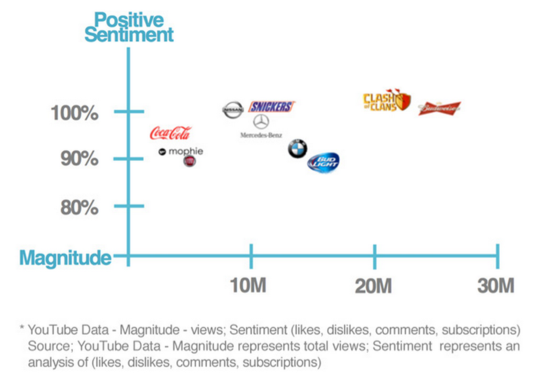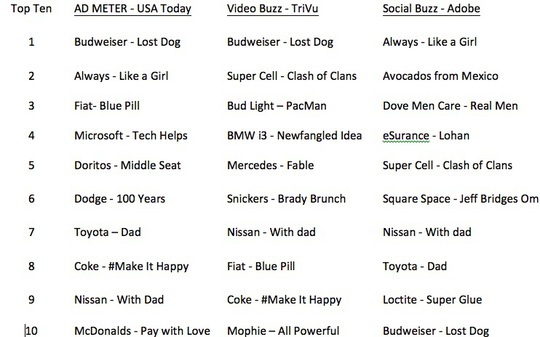Here Are the Top 10 2015 Super Bowl Ads Based On Reach And Sentiment
As pundits on TV, around water coolers, and in sports bars debate the merits of the calls from this Sunday's Super Bowl, advertisers are making their own calls on whether their ads scored a touchdown or missed the goal line by inches.
Adknowledge's TriVu media took it upon themselves to crunch the numbers to arrive at an understanding of the the real Super Bowl Ad winners based on data and true "video buzz".
To assemble the list of top ten TriVu worked in partnership with data science firm TeraCrunch to analyze over 200 million views and nearly a million comments on YouTube. The analysis takes into account views, likes, dislikes, subscriptions and sentiment.
Why YouTube? It's the dominant social marketing platform during Super Bowl Sunday. Consider the following:
- Facebook boasted 65 million posts about game-related content within the first 24 hours after the Super Bowl.
- Twitter tapped out 28.4 million related tweets.
- As of Monday evening, YouTube views of Super Bowl ads were over 188 million.
YouTube is also a great predictor of the valuable 18-34 demographic since this demo spends 44% more time watching online video and 36% more time watching YouTube than the average online user, according to comScore.
When compiling our their ten list, AdKnowledge looked at two different dimensions: magnitude and positive sentiment.
"Magnitude" represents the effective reach of an ad; specifically, it measures how many consumers viewed the spot. You can have an amazing ad on Super Bowl Sunday, but if only 10,000 saw it online, your advertising ROI will be less than you hoped. To calculate magnitude, the analysis took the straightforward "view number" through 48 hours after the Super Bowl aired.
"Sentiment" is defined by the degree of emotional response viewers feel for an ad. At the end of the day, positive or negative sentiment and the intensity of that feeling is what motivates people to act. When people feel intensely about something, people tend to want to share it. The more intense the emotion, the more likely it is to become part of your memory. To calculate sentiment, we looked at likes, dislikes, comments, subscriptions and sentiment.
Predictably, Budweiser's "Lost Dog" spot has the highest combined score. Indeed, it also scored in the top spot on the USA Today's Ad Meter and was in the top ten of Adobe's social media buzz. The ad has been seen over 24 million times and has a positive sentiment (intensity) score of over 97%.
Close behind in second place was SuperCell's "Clash of Clans" ad, featuring actor Liam Neeson. The spot is a parody of the "Taken" movie franchise in which Neeson threatens to go after another player who is trying to take his gold. The ad has been seen over 20 million times and has a positive sentiment (intensity) score of 96%
In third place is Bud Light's "Pacman", followed by BMW's "Newfangled Idea" and Mercedes-Benz's "Fable".
Top ten ads are:
1. Budweiser's "Lost Dog"
2. SuperCell's "Clash of Clans: Revenge"
3. Bud Light's "Real Life Pac Man"
4. BMW i3's "Newfangled Idea"
5. Mercedes-Benz's "Fable"
6. Snickers' "The Brady Brunch"
7. Nissan's "With Dad"
8. Fiat's "The FIAT Blue Pill"
9. Coca-Cola's "#Make It Happy"
10. Mophie's "All-Powerless"
Plotting these ads across two dimensions looks like this:
"These ads did well on YouTube because they had a great creative concept and effective online video marketing strategy that resonated with their audience," says Paul Calento, co-founder of TriVu Media.
Conclusions
As the Super Bowl hype finally dies down, advertisers and brands can use the game as a case study as they finalize their planning for the next big event--be it the Oscars, Final Four or NBA Finals.
1. Magnitude is good, but not always at the expense of sentiment
Some of the most watched ads also had the greatest level of negative sentiment. Ads such as T-Mobile's "Save the Data" and Nationwide's "Boy Accident" each received more than 60 and 75% negative sentiment respectively.
Magnitude is "reach." And reach is nice, but so what? We all see hundreds of ads a day; most of them wash over us and fade away. We want to deliver advertising experiences that are intense, affecting and "sticky." If a few viewers are motivated enough to engage with a video rather than just watching it probably indicates that the overall level of experience intensity is higher, and that the message is more likely to stick for more people.
2. Early is better
Six out of the top ten ads were released prior to the Super Bowl. Indeed, if it aligns with your business goals, brands should release their ads online before big events, whether it's for the upcoming MTV Music Awards or the NCAA's March Madness.
Consumers watched Super Bowl ads 86 million times before Sunday's kickoff. With over 50 ads in the game, plus a need to refill your beverage and guacamole dip, it's hard to watch every single commercial. Last year, commercials released on YouTube before they aired during the Super Bowl drove 2.5x more views on average than those released on game day. In fact, consumers are beginning to expect it. Last year, we watched one in five ads before the game. Expect that number to be higher when the numbers are tabulated this year.
3. Scorecards differ between offline and online
The ads that performed the best on TV are not the ones that necessarily do the best online. In fact, Square Space's "Om Sleep" starring actor Jeff Bridges was a hit online but was one of the worst ads as rated by the USA Today Ad Meter. Conversely, Microsoft and Dodge were top ten TV winners but didn't generate the same kind of online video or social buzz as other Super Bowl advertisers:
In a sponsored content study AdKnowledge published in a recent AdAge article it was found that the Super Bowl advertisers that amplified their brands online days and weeks after the Super Bowl had greater recall than those that just promoted their spot with a burst of advertising. 1,000 people were surveyed and it was found that the brands employing this strategy had 2X better recall than those that didn't.
4. Targeting online is key in social networking and video marketing
Ads are created to guide audiences to take an action. On TV, advertisers buy time on programs, but they're essentially buying an audience. Buying advertising at the actual video (URL) level on YouTube is important because you can understand--at the most granular level--which placements get the best response from viewers.
Last year, TriVu Media managed a large automaker's Super Bowl YouTube campaign and found that content from specific artists, gaming and sports had better view-through rates than others. TriVu used this to help the advertiser make recommendations for the next big sports-related media buy. Based on this data, TriVu makes on-the-fly optimizations, as well as provides recommendations to be leveraged in future media buys.
5. Skip the brag deck and conduct a Super Bowl post-mortem.
Every agency should provide their brands with at least 10 things they would do differently next year; what they learned from targeting and which plays they will steal from a competitor or fellow Super Bowl advertiser in the future.
The most important metrics are the ones that are most important to the brand. Many brands are lulled into the false notion that impressions, views and clicks are the ultimate barometers of success. Metrics are less important than specific outcomes. A brand should figure out what it specifically wants: sales, engagement, emails, etc. Then work backwards from there.
This guest article was written by AdKnowledge TriVu.




